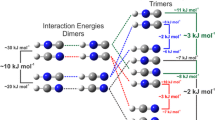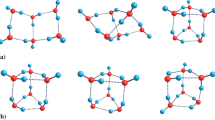Abstract
Hydrate effects on the conformations of ethylene oxide oligomers (EO-x, x = 1–8 mers) were examined using quantum chemical calculations (QCC). Conformational analyses were carried out by RHF/6-31G. The models were constructed by locating a water molecule to each ether–oxygen in the structures optimized for non-hydrate oligomers. Hydrate ratio, h (h = H2Omol/Omol in oligomer), was set from 0 to 1.0. The six type conformations with repeated units of O–C, C–C and C–O bonds were examined. Conformational energy, E c (HF), was calculated as difference between the energy of oligomer with water molecules and that of non-hydrogen and/or hydrogen bonding water molecules. Hydrate energies for each conformer, ∆μ h (kcal/m.u., based on E c in non-hydrate state), were negative and linearly decreased with the increase of h values, and such effects with the increase of h values were weaken with increasing x values. These results were consistent with our previous results calculated using the permittivity, ε (ε = 0–80.1), by QCC. In non-hydrate (h = 0), the (ttt) x conformers were the most stable independent of x. However, in hydrate states (h = 0.44–0.67), the (tg+t) x conformers were the most stable independent of x values, and in h = 1, the (tg+t)8 conformer (8-mer) was most stable [∆E c(g) = −1.3 kcal/m.u., ∆E c(g): energy difference between a given oligomer and the (ttt) x oligomer]. These results supported the experimental those based on NMR analyses using dimethoxyethane and triglyme solutions. Molecular lengths (l) of (tg+t) x , (tg+g−) x and (g+g+g+) x conformers having higher x values significantly decreased with increasing h values. Such contraction with hydration, however, was independent of ΔE c(g) values of each conformer.







Similar content being viewed by others
References
Ries ME, Brereton MG, Cruickshank JM, Klein PG, Ward IM (1995) Macromolecules 28:3282
Takahashi Y, Tadokoro H (1973) Macromolecules 6:672
Takahashi Y, Sumita I, Tadokoro H (1973) J Polym Sci Polym Phys Ed 11:2113
Tasaki K, Abe A (1985) Polym J 17:641
Sasanuma Y, Ohta H, Touma I, Matoba H, Hayashi Y, Kaito A (2002) Macromolecules 35:3748
Sasanuma Y, Sugita K (2006) The attractive Gauche effect of ethylene oxides. Polym J 38:983
Mark JE, Flory PJ (1965) The configuration of the polyoxyethylene chain. J Am Chem Soc 87:1415
Mark JE, Flory PJ (1966) Dipole moments of chain molecules. I. Oligomers and polymers of oxyethylene. J Am Chem Soc 87:3702
Geun G, Breitkreutz J (1994) Structures and molecular attributes of polyethylene glycols. Pharmazie 49:562
Dong H, Hyun JK, Durham C, Wheeler RA (2001) Polymer 42:7809
Tsuzuki S, Uchimaru T, Tanabe K, Hirano T (1993) J Phys Chem 97:1346
Smith GD, Yoon DY, Jaffe RL (1993) Macromolecules 26:5213
Smith GD, Borodin O, Bedrov D (2002) J Comput Chem 23:1480
Kobayashi M, Sato H (2008) Conformational analysis of ethylene oxide and ethylene imine oligomers by quantum chemical calculations. Polym J 40:343
Kobayashi M, Sato H (2008) Conformational analysis of ethylene oxide and ethylene imine oligomers by quantum chemical calculations: solvent effects. Polym Bull 61:529
Foresman JB, Keith TA, Wiberg KB, Snoonian J, Frisch MJ (1996) J Phys Chem 100:16098
Gaussian 03 User’s Reference (2003) Gaussian Inc., PA, USA
Lide DR (2001) Handbook of chemistry and physics. 82nd edn. CRC Press LLC, London, pp 8–127
Ludwig R (2001) Water: from clusters to the bulk. Angew Chem Int Ed 40:1808
Dyke TR, Mack KM, Muenter JS (1977) J Chem Phys 66:498
Odutola JA, Dyke TR (1980) J Chem Phys 72:5062
Sasanuma Y, Hattori S, Imazu S, Ikeda S, Kaizuka T, Iijima T, Sawanobori M, Azam MA, Law RV, Steinke JHG (2004) Macromolecules 37:9169
Author information
Authors and Affiliations
Corresponding author
Rights and permissions
About this article
Cite this article
Kobayashi, M., Takahashi, M. & Sato, H. Conformational analysis for hydrated ethylene oxide oligomer models by quantum chemical calculations. Polym. Bull. 63, 299–312 (2009). https://doi.org/10.1007/s00289-009-0081-8
Received:
Revised:
Accepted:
Published:
Issue Date:
DOI: https://doi.org/10.1007/s00289-009-0081-8




